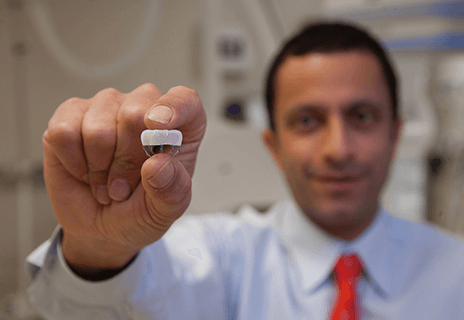Watchman Implant Procedure
Catheter Ablation, a procedure conducted via catheter, helps lessen atrial fibrillation symptoms by preventing the heart from receiving abnormal signals.
In a catheter ablation procedure, a catheter is guided to the heart through a blood vessel. The catheter delivers energy to destroy cells within the heart that send abnormal signals. Depending on the type of AFib you suffer from and whether you can take medication for your condition, your doctor may recommend a left atrial ablation procedure, an AV node ablation procedure, or a maze procedure.

What is a Watchman Implant?
There are other treatments for AFib, in addition to medication. One is a Watchman Implant. What is it, and what do you need to know? You may have seen information online or on TV about AFib medications. Here are a few quick points about the Watchman device, a one-time, minimally invasive procedure versus a lifelong use of blood thinners.
Patients who have atrial fibrillation, are at risk of having a stroke, and are looking for an alternative to taking blood thinners can benefit significantly from Watchman Implant technology. By closing off the left atrial appendage, where blood clots often form in people with AFib, this small device in the shape of a parachute lowers the risk of having a stroke.
The procedure for implantation is minimally invasive, is usually done under general anesthesia, and most people only need a short stay in the hospital. After a few days, most people can go back to their normal activities.
Many studies have been done on The Watchman, and it has been shown to be as good at preventing strokes as blood thinners. It also has the added benefit of lowering the risk of bleeding that comes with long-term anticoagulation therapy. It only takes one procedure to protect you for life, which could mean you do not need to take medicine every day or get blood tests regularly.
Many people who get the Watchman Implant say it improves their lives and gives them peace of mind.
Could you be a good candidate for a Watchman Implant? Read on to learn more.
Frequently Asked Questions
A Watchman Implant is a small device placed in the heart to reduce the risk of stroke in patients with non-valvular atrial fibrillation (AFib). AFib patients are at an increased risk of stroke due to blood clots forming in a small chamber of the heart known as the left atrial appendage (LAA). AFib affects your heart’s ability to pump blood and can cause blood to pool in the left atrial appendage. The Watchman Implant is a minimally invasive procedure designed for AFib patients who need an alternative to blood thinners.
The Watchman Implant reduces the risk of stroke by permanently closing off the left atrial appendage to prevent blood clots from escaping. The Watchman, or left atrial appendage closure device, is about the size of a quarter and effectively seals off this part of the heart where blood clots form. Closing off this area is an effective way to reduce the risk of stroke in patients whose AFib is not caused by a heart valve problem.
During the Watchman Implant procedure, your doctor will make a small incision in your leg and insert a narrow tube. The Watchman device will be guided through the tube and placed into your left atrial appendage. Over time, heart tissue will grow over the implant, forming a barrier against blood clots. Eventually, the left atrial appendage will close permanently.
Your doctor will make a small cut in your upper leg during the procedure. A narrow tube is then inserted through the veins of the leg, and the Watchman Implant is guided into the left atrial appendage of your heart.
Does the Watchman need to be replaced?
The Watchman Implant is a permanent device implanted into your heart’s left atrial appendage in a one-time procedure. The device lasts a lifetime and does not need to be replaced.
Please arrive at your appointment on time to prepare for your procedure as instructed by the doctor.
When you arrive on the day of your appointment, you will be asked to change into a gown to prepare for the procedure. We will monitor your blood pressure, heart rate, and oxygen levels. We will insert an IV to administer anesthesia.
You will undergo general anesthesia during the procedure. The procedure is not open-heart surgery, as the device is inserted through your leg. A catheter will be inserted into a blood vessel in your upper leg. The catheter will then be guided through the blood vessel to the heart and into the left atrial appendage. Once the Watchman device is in place, it will be deployed. This procedure generally takes about one hour to complete. You can expect to stay in the hospital overnight for monitoring and go home the following day.
After the Watchman has been implanted, you will need to continue taking blood thinners for 45 days post-procedure or until your left atrial appendage is completely closed. By 45 days, the left atrial appendage should be fully sealed, preventing blood clots from forming and escaping. We will monitor your progress and advise you on when it is safe to stop taking blood thinners. Studies have shown that 96% of people who had the Watchman device implanted were able to stop taking blood thinners within 45 days, and more than 92% were able to stop taking blood thinners one year after the procedure.
If you suffer from non-valvular atrial fibrillation and would like to learn more about the benefits of the Watchman Implant, schedule an appointment with Cardiovascular Group today! Our dedicated team of cardiologists will guide you through the procedure and answer any questions you may have. Our doctors are committed to heart care, treating heart disease and related conditions, and improving overall heart health. As a patient, you will receive high-quality care from top physicians. Your heart health and treatment are our top priorities.

